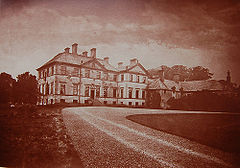Craigiehall
| Craigiehall | |
|---|---|

Old view of Craigiehall, showing the house with Bruce's roof and chimneys in place, and the pediment still on Burn's extension (right)
|
|
| General information | |
| Town or city | Near Edinburgh |
| Country | Scotland |
| Construction started | c. 1695 |
| Completed | 1699 |
| Client | William Johnstone, 2nd Earl of Annandale |
| Design and construction | |
| Architect | Sir William Bruce |
Craigiehall is a late-17th-century country house, which until 2015 served as the Headquarters of the British Army in Scotland. It is located close to Cramond, around 9 km (5.6 mi) west of central Edinburgh, Scotland.
Craigiehall was designed by Sir William Bruce, with input from James Smith, and completed in 1699 for the Earl of Annandale, who had recently acquired the Craigie estate through marriage. It is a good surviving example of one of Bruce's smaller houses, and set a pattern for such villas in the Edinburgh area for the 18th century.
It was later the home of Charles Hope-Weir, who made several improvements to the estate policies. Craigiehall was extended several times, before being sold to the Earl of Rosebery, who leased out the property. It was briefly a hotel and country club, before being requisitioned by the Army at the outbreak of the Second World War. Craigiehall continues to be used as the Army's Scottish Headquarters. The house has been protected as a category A listed building since 1971, as a substantial 17th-century classical house, worked on by several notable architects.
The estate of Craigie is recorded as belonging to one John de Craigie in the reign of David I (1124–1153). In 1387 the estate passed by marriage to John Stewart, son of Sir Robert Stewart of Durisdeer. The Stewarts sold the estate, which by this time had a tower house, in 1643 to John Fairholm, treasurer to the City of Edinburgh. In 1682 John Fairholm's granddaughter Sophia, aged only 14, married William Johnstone, 2nd Earl of Annandale, and Craigiehall changed ownership again. Only two built features on the estate date from before this time; the 17th century east sundial, and the ruined doocot, or pigeon house, dated 1672. The east sundial is one of only 25 obelisk-type sundials in Scotland, and was re-erected to the east of the house in 1965, after being found in a field to the south of the house.
...
Wikipedia
